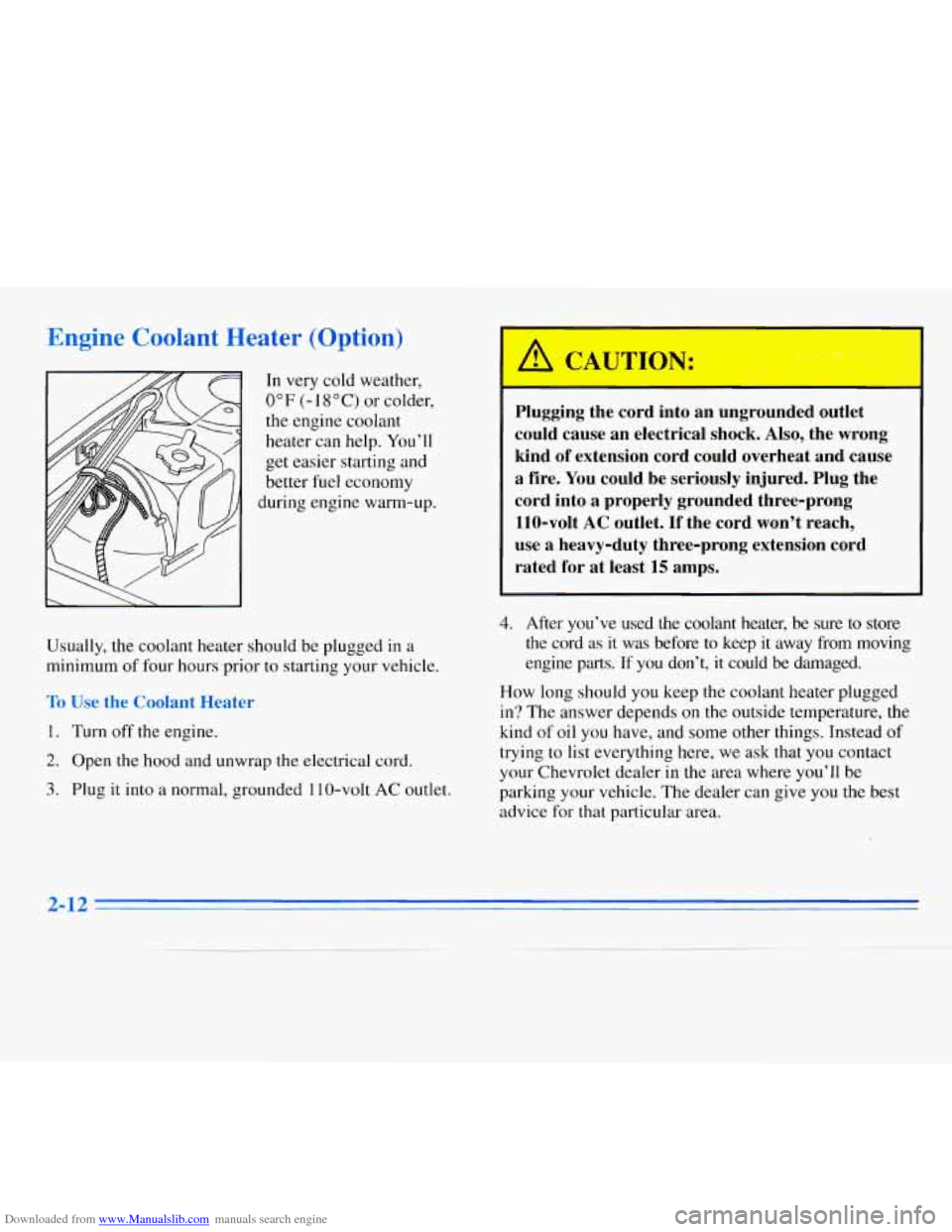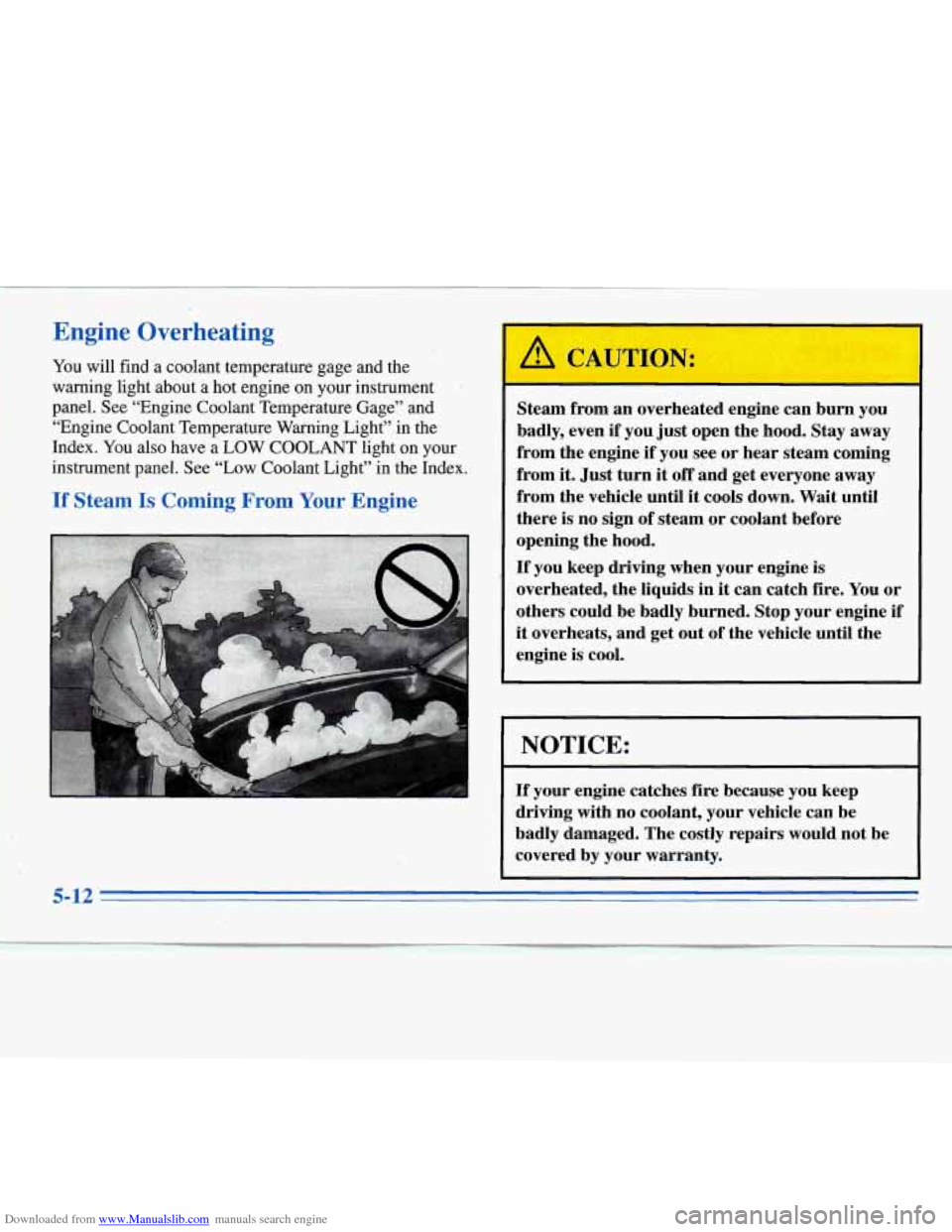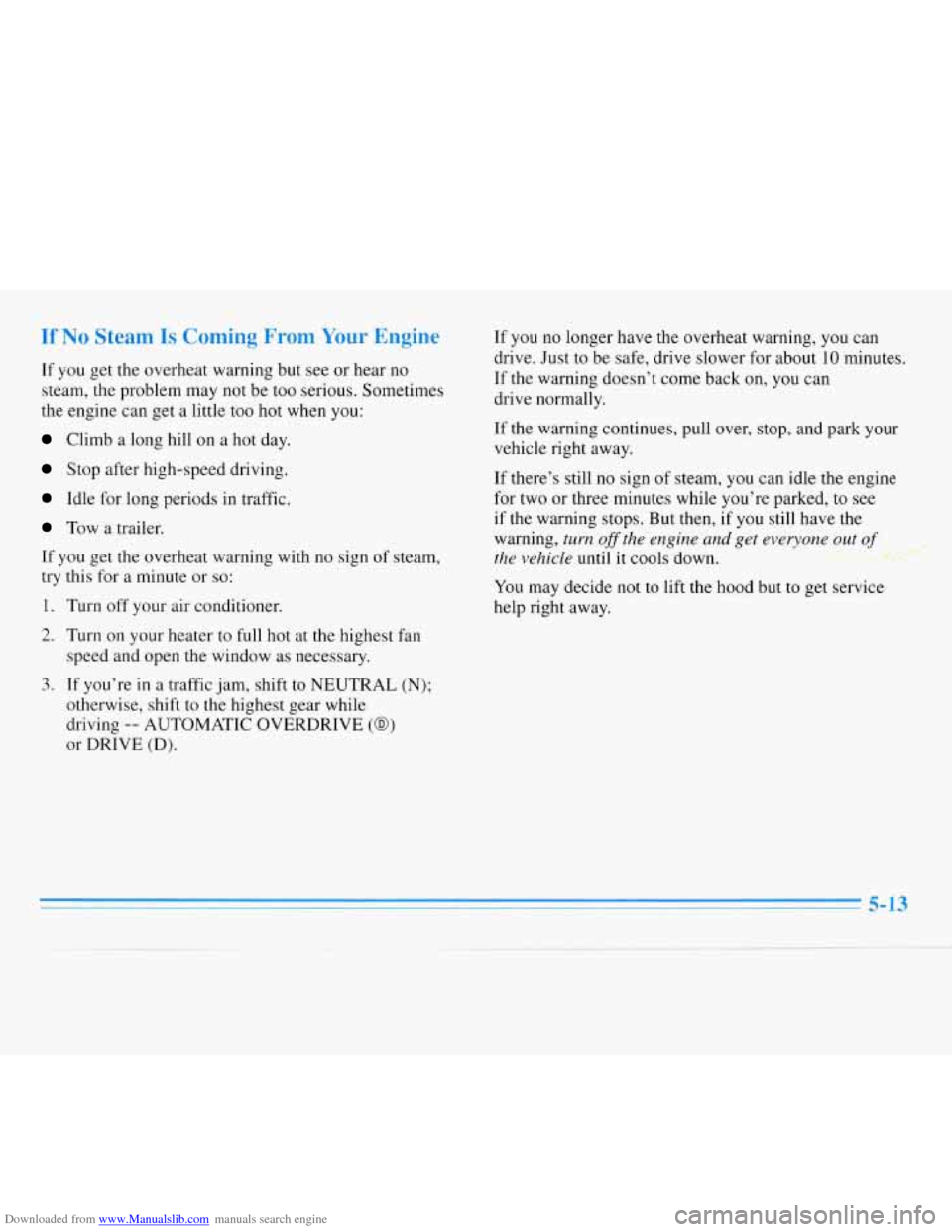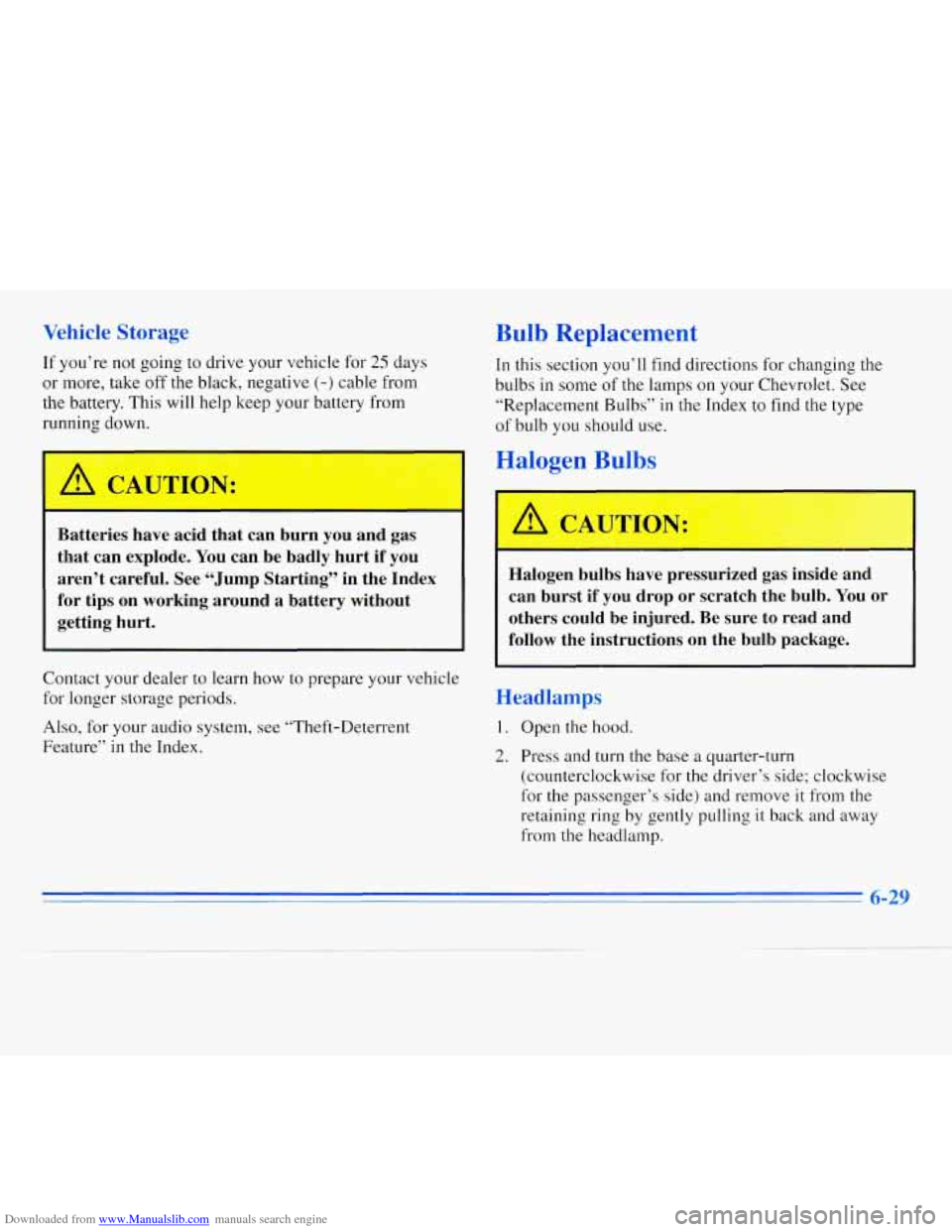Page 70 of 340

Downloaded from www.Manualslib.com manuals search engine Engine Coolant Heater (Option)
In very cold weather,
0°F (- 1 S’C) or colder,
the engine coolant
heater can help. You’ll
get easier starting and
better
fuel economy
during engine warm-up.
Usually, the coolant heater should be plugged in a
minimum of four hours prior to starting your vehicle.
To Use the Coolant Heater
1. Turn off the engine.
2. Open the hood and unwrap the electrical cord.
3. Plug it into a normal, grounded 1 10-volt AC outlet.
’ .A CAUTION:
1 - - -+* ,
Plugging the cord into an ungrounded outlet
could cause an electrical shock.
Also, the wrong
kind of extension cord could overheat and cause
a fire. You could be seriously injured. Plug the
cord into a properly grounded three-prong
110-volt
AC outlet. If the cord won’t reach,
use a heavy-duty three-prong extension cord
rated for
at least 15 amps.
4.
After you’ve used the coolant heater, be sure to store
the cord
as it was before to keep it away from moving
engine parts. If you don’t, it could be damaged.
How long should you keep the coolant heater plugged
in? The answer depends on the outside temperature, the
kind of oil you have, and some other things. Instead of
trying to
list everything here, we ask that you contact
your Chevrolet dealer in
the area where you’ll be
parking your vehicle. The dealer can give you the best
advice for that particular area.
2-12
Page 184 of 340

Downloaded from www.Manualslib.com manuals search engine Engine Overheating
. e You will find a coolant temperature gage and the
. warning light about a hot engine on your instrument
panel. See “Engine Coolant Temperature Gage” and
“Engine Coolant Temperature Warning Light” in the
Index. You also have a LOW COOLANT light on your
instrument panel. See “Low Coolant Light” in the Index.
If Steam Is Coming From Your Engine
-
Steam from an overheated engine can burn you
badly, even
if you just open the hood. Stay away
from the engine
if you see or hear steam coming
from
it. Just turn it off and get everyone away
from the vehicle until it cools down. Wait until
there is no sign of steam or coolant before
opening the hood.
If you keep driving when your engine is
overheated, the liquids in it can catch fire. You or
others ‘could be badly burned. Stop your engine
if
it overheats, and get out of the vehicle until the
engine is cool..
NOTICE:
If your engine catches fire because you keep
driving with no coolant, your vehicle can be
badly damaged. The costly repairs would not be
covered
by your warranty.
5-12
Page 185 of 340

Downloaded from www.Manualslib.com manuals search engine If No Steam Is Coming From Your Engine
If you get the overheat warning but see or hear no
steam, the problem may not be too serious. Sometimes
the engine can get a
little too hot when you:
Climb a long hill on a hot day.
Stop after high-speed driving.
Idle for long periods in traffic.
Tow a trailer.
If you get the overheat warning with
no sign of steam,
try this for a minute or
so:
1. Turn off your air conditioner.
2. Turn on your heater to full hot at the highest fan
speed and open the window as necessary.
If you no longer have the overheat warning, you can
drive. Just to be safe, drive slower for about
10 minutes.
If the warning doesn’t come back on, you can
drive normally.
If the warning continues, pull over, stop, and park your
vehicle right away.
If there’s still no sign of steam, you can idle the engine
for two or three minutes while you’re parked,
to see
if the warning stops. But then, if you still have the
warning,
turn ofthe engine and get everyone out of . p~
the vehicle until it cools down. *! ?rLw&pa
You may decide not to lift the hood but to get service
help right away.
3. If you’re in a traffic jam, shift to NEUTRAL (N);
otherwise, shift to the highest gear while
driving
-- AUTOMATIC OVERDRIVE (@)
or DRIVE (D).
.
Page 214 of 340
Downloaded from www.Manualslib.com manuals search engine Checking Things Under the Hood
An' electric fan under the hood'can' start up and
injure you even when the engine
is not running.
Keep hands, clothing and tools away from any
underhood electric fan.
I
Things that burn can get on hot engine parts and
start
a fire. These include liquids like gasoline,
oil, coolant, brake fluid, windshield washer and
other fluids, and plastic or rubber. You or others
could be burned. Be careful not to drop or spill
things that will burn onto a hot engine.
Hood Release
To open the'hood, first pull
the handle inside the vehicle.
Then
go to the front of the
vehicle and release the secondary hood release.
Lift the hood.
6-6 -
Page 215 of 340
Downloaded from www.Manualslib.com manuals search engine When you open the hood on the 3.1 L L82 (Code M) engine, you’ll see:
A. Engine Coolant Reservoir
B. Radiator Fill Cap
C. Power Steering Fluid Reservoir
D. Engine Oil Fill Cap
E. Engine
Oil Dipstick
E Automatic Transaxle Dipstick
G. Brake Fluid Reservoir
H. Air Cleaner
I. Windshield Washer Fluid Reservoir
J. Batte~y (located under Windshield Washer Reservoir)
Page 216 of 340
Downloaded from www.Manualslib.com manuals search engine !i
When you open the hood on the 3.4L LQ1 (Code X) engine, you’ll see:
A. Engine Coolant Reservoir
B. Radiator Fill Cap
C. Power Steering Fluid Reservoir
D. Engine Oil Fill Cap
E. Engine Oil Dipstick
E Automatic Transaxle Dipstick
G. Brake Fluid Reservoir
H. Air Cleaner
I. Windshield Washer Fluid Reservoir
J. Battery (located under Windshield Washer Reservoir)
6-8 II
Page 237 of 340

Downloaded from www.Manualslib.com manuals search engine Vehicle Storage
If you’re not going to drive your vehicle for 25 days
or more, take off the black, negative
(-) cable from
the battery. This
will help keep your battery from
running down.
’ I A CAUTION:
Batteries have acid that can burn you and gas
that can explode. You can be badly hurt
if you
aren’t careful. See “Jump Starting” in the Index
for tips on working around
a battery without
getting hurt.
Bulb Replacement
In this section you’ll find directions for changing the
bulbs
in some of the lamps on your Chevrolet. See
“Replacement Bulbs”
in the Index to find the type
of bulb you should use.
Halogen Bulbs
Contact your dealer to learn how to prepare your vehicle
for longer storage periods.
Also, for your audio system, see “Theft-Deterrent
Feature”
in the Index.
Halogen bulbs have pressurized gas inside and
can burst if you drop or scratch the bulb. You or
others could be injured. Be sure to read and
follow the instructions on the bulb package.
Headlamps
1. Open the hood.
2. Press and turn the base a quarter-turn
(counterclockwise for the driver’s side; clockwise
for the passenger’s side) and remove
it from the
retaining ring by gently pulling
it back and away
from the headlamp.
6-29
Page 238 of 340
Downloaded from www.Manualslib.com manuals search engine 3.
4.
5.
6.
Remove the electrical connector from the bulb by
raising the lock tab and pulling the connector away
from the bulb's base.
Install the electrical connector to the bulb.
Install the new bulb by inserting the smallest tab on
the bulb base into the matching notch
in the retaining
ring.
Turn the bulb a quarter-turn clockwise until
it stops.
Close the hood.
Front Park and Turn Signal Lamp
1. Open the hood. There is one flap on each side of
the radiator.